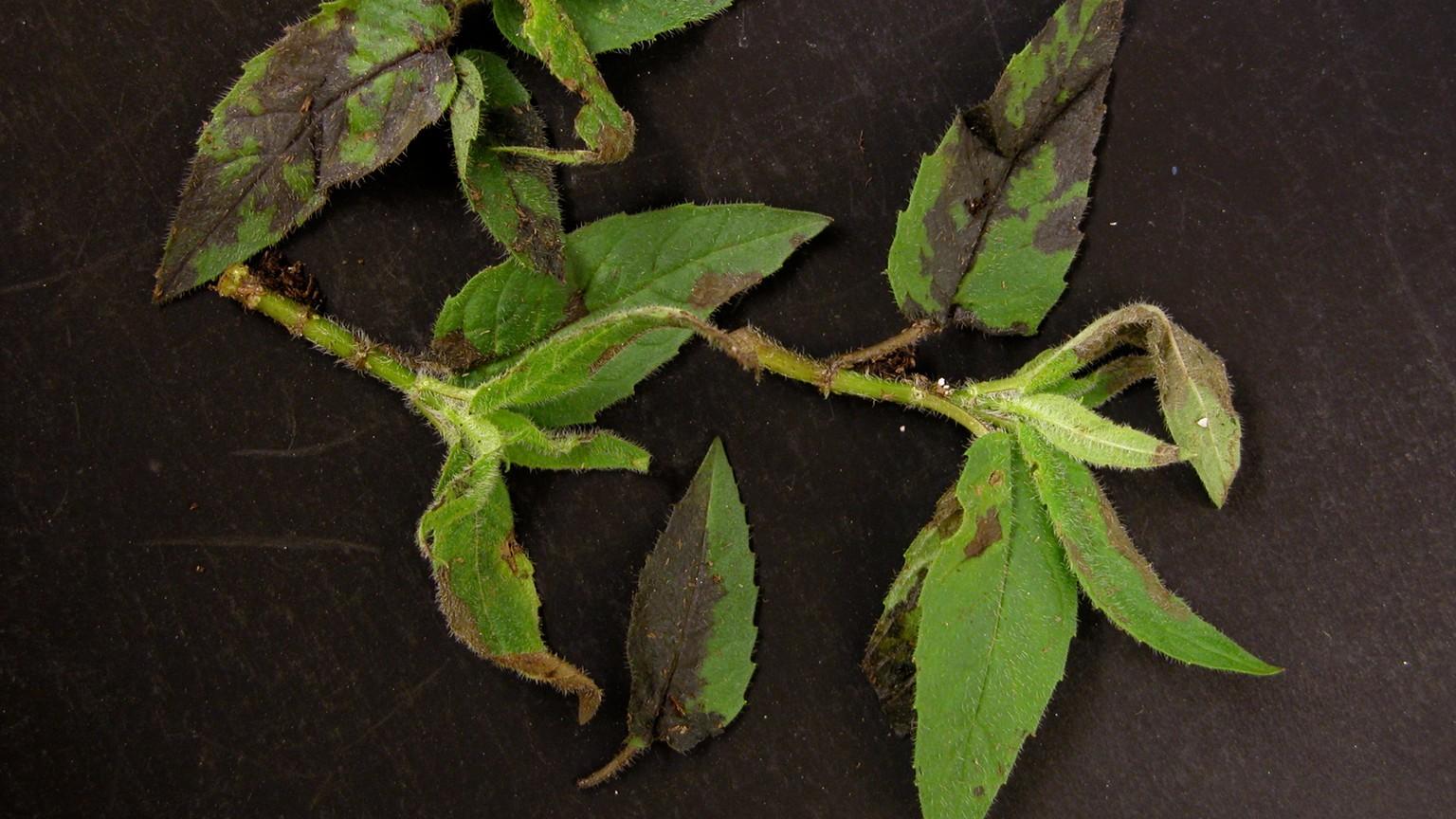Bacteria are single-celled, microscopic organisms, bounded by a cell wall, that cause plant diseases. Bacteria are much smaller than fungi and nematodes but can cause severe symptoms. Bacterial pathogens can cause soft rots, vascular wilts, leaf spots, and blights as well as secondary infections. Commonly encountered genera include Erwinia, Xanthomonas, Pseudomonas, Corynebacterium, and Agrobacterium.
Bacterial leaf spots and blights can occur at the same time as fungal leaf spots and diagnosis can sometimes be difficult. Bacterial leaf spot symptoms on older leaves typically have a more angular appearance than fungal leaf spots, with the spots bounded between the veins. If a new leaf or shoot collapses quickly, often with a "slimy dark appearance" then it is called a blight. Often if the leaf is held up to a light source, and viewed backlighted, a water soaked area around the dead tissue can sometimes be seen and on some perennials, the bacterial leaf spots will have a definite yellow outline or halo. Severely rotted tissue will often have a "rotten smell" because of secondary infection from other common bacteria found in soil and on plant surfaces. Warm weather and prolonged wet periods frequently encourage bacterial infections. Examples: Larkspur (photos below).


Monitor
Bacterial diseases are frequently introduced into the growing area by planting previously infected plants. They generally don't persist long in soil or planting media unless plant debris from previous crops is abundant. However, old potting media stored on unprotected ground, or the use of contaminated tools should be avoided. Under field conditions, low areas that collect water runoff will be more prone to bacterial problems. Bacterial diseases are spread by water and are carried in infected plant debris. In the lab, infected plants can be inspected for bacterial streaming under a microscope.

Management
Only healthy transplants should be planted into home gardens because of the potential for introduction of bacterial pathogens into the soil or as a source of infection. Inspection of new plants or detection and prompt removal of established plants with symptoms is often the best way of managing disease outbreaks. Foliar infections can sometimes be reduced by removal of spotted leaves. Alleviate poor air circulation and crowded conditions, and if possible avoid overhead irrigation late in the day to lower humidity levels.
 English
English العربية
العربية Български
Български 简体中文
简体中文 繁體中文
繁體中文 Hrvatski
Hrvatski Čeština
Čeština Dansk
Dansk Nederlands
Nederlands Suomi
Suomi Français
Français Deutsch
Deutsch Ελληνικά
Ελληνικά हिन्दी
हिन्दी Italiano
Italiano 日本語
日本語 한국어
한국어 Norsk bokmål
Norsk bokmål Polski
Polski Português
Português Română
Română Русский
Русский Español
Español Svenska
Svenska Català
Català Filipino
Filipino עִבְרִית
עִבְרִית Bahasa Indonesia
Bahasa Indonesia Latviešu valoda
Latviešu valoda Lietuvių kalba
Lietuvių kalba Српски језик
Српски језик Slovenčina
Slovenčina Slovenščina
Slovenščina Українська
Українська Tiếng Việt
Tiếng Việt Shqip
Shqip Eesti
Eesti Galego
Galego Magyar
Magyar Maltese
Maltese ไทย
ไทย Türkçe
Türkçe فارسی
فارسی Afrikaans
Afrikaans Bahasa Melayu
Bahasa Melayu Kiswahili
Kiswahili Gaeilge
Gaeilge Cymraeg
Cymraeg Беларуская мова
Беларуская мова Íslenska
Íslenska Македонски јазик
Македонски јазик יידיש
יידיש Հայերեն
Հայերեն Azərbaycan dili
Azərbaycan dili Euskara
Euskara ქართული
ქართული Kreyol ayisyen
Kreyol ayisyen اردو
اردو বাংলা
বাংলা Bosanski
Bosanski Cebuano
Cebuano Esperanto
Esperanto ગુજરાતી
ગુજરાતી Harshen Hausa
Harshen Hausa Hmong
Hmong Igbo
Igbo Basa Jawa
Basa Jawa ಕನ್ನಡ
ಕನ್ನಡ ភាសាខ្មែរ
ភាសាខ្មែរ ພາສາລາວ
ພາສາລາວ Latin
Latin Te Reo Māori
Te Reo Māori मराठी
मराठी Монгол
Монгол नेपाली
नेपाली ਪੰਜਾਬੀ
ਪੰਜਾਬੀ Afsoomaali
Afsoomaali தமிழ்
தமிழ் తెలుగు
తెలుగు Yorùbá
Yorùbá Zulu
Zulu ဗမာစာ
ဗမာစာ Chichewa
Chichewa Қазақ тілі
Қазақ тілі Malagasy
Malagasy മലയാളം
മലയാളം සිංහල
සිංහල Sesotho
Sesotho Basa Sunda
Basa Sunda Тоҷикӣ
Тоҷикӣ O‘zbekcha
O‘zbekcha አማርኛ
አማርኛ Corsu
Corsu Ōlelo Hawaiʻi
Ōlelo Hawaiʻi كوردی
كوردی Кыргызча
Кыргызча Lëtzebuergesch
Lëtzebuergesch پښتو
پښتو Samoan
Samoan Gàidhlig
Gàidhlig Shona
Shona سنڌي
سنڌي Frysk
Frysk isiXhosa
isiXhosa